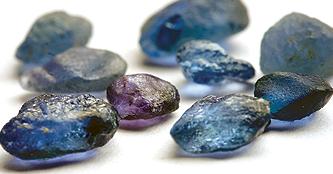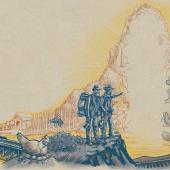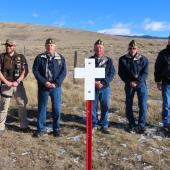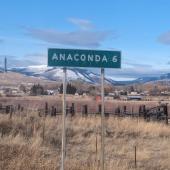Yogo Sapphire - Montana's "Goldilocks" Gem
Sapphires are hard, beautiful, and rare, all the qualities that make a first-class gemstone. Most have come from remote exotic locations like Kashmir, Sri Lanka, and Madagascar, and in the United States a few sapphires occur in North Carolina. But the Treasure State harbors sapphires that measure up with the best in the world, and sapphire is so distinctly Montana that it was designated a state gem, together with Montana agate, in 1969.

Yellow, pink, green, and purple corundum specimens are all sapphire (red corundum is called ruby), but the most valued varieties are deep blue. Gem dealers seek cornflower blue, nearly a reflection of Montana’s Big Sky. Yogo Gulch, in Judith Basin County on the flank of the Little Belt Mountains, produces elegant gems of just this color, beautiful enough that Yogo sapphires found their way into Tiffany jewelry and the Smithsonian’s gem collection, which holds a 10.2-carat cut stone believed to be the largest cut Yogo ever made.
Dick Berg, industrial minerals geologist with the Montana Bureau of Mines and Geology in Butte, is clear on one thing: after studying them for a decade, he doesn’t know why the 48-million-year-old Yogos are deep blue while other Montana sapphires such as those from the Rock Creek District west of Philipsburg are much lighter shades, requiring heat treatment to create gems. But he speculates that the rocks’ cooling history may have something to do with it. Longer cooling times might allow the titanium and iron to spread more uniformly through the crystals, affecting the color. Yogos result from the luck of geology—just the right elements and just the right cooling history making a “Goldilocks” gem that is just about perfect.
Early gold prospectors discarded the curious blue stones that concentrated in their gold pans and sluices, but by 1895 sapphire gem mining at Yogo Creek was a reality. The first almost accidental mining reportedly earned Jake Hoover $3,750—a fortune, and five times what Hoover made on gold—from the Tiffany Company. Tiffany’s gemologist, George F. Kunz, had written Gems and Precious Stones of North America just five years earlier and had known of the lower-quality Missouri River sapphires for 30 years. He recognized quality when he saw it in Hoover’s Yogos. Hoover sold his share in the “mere gold mine,” as Kunz called it, for $5,000, but within a few months, British investors bought the property for $100,000.

Thanks in part to the British connection and European gem cutting centers, a few Yogos probably made their way into the personal collections of British royalty in the 1910s, but a popular suggestion that the Crown Jewels of England contain Yogos is likely a myth. In 1998, the late Montana geologist David Baker contacted Leslie Field, expert on the Crown Jewels. She told Dr. Baker, “I am not aware of any Yogo Gulch sapphires set in any piece of jewelry belonging to a member of the British family.” The suggestion that Princess Diana’s engagement ring contains a Yogo sapphire is likewise probably not true—the stone is much too large and probably came from Sri Lanka.
Debunking the Crown Jewels myth doesn’t reduce Yogo sapphires’ value at all. They remain the premier gemstones from North America, just as Kunz characterized them in the 1890s, and as some of the very few naturally cornflower-blue stones in the world, their desirability continues to grow.
Profitability of Yogo mining operations varied throughout the twentieth century. Work was effectively suspended after a flash flood in 1923 destroyed mine structures, and sporadic later efforts were generally unsuccessful. In the early 1970s California investors began Sapphire Village, a small real estate development that allowed property owners to explore for gems. Diverse mine ownership saw minimal profit for the next 15 years, until the Vortex Mine opened in 1984 and turned a profit for a few years by exploiting two underground sapphire-bearing dikes. In 2004 the Vortex Mine closed because the dike rock was too hard to free sapphires effectively and investors were dissatisfied with production.
In 2008, new mine owner Mike Roberts gave up on gold mining in Alaska and began to operate the Vortex Mine, establishing a bright new future for Montana sapphires. Profitable gem production comes from the 300-foot level in a mine that may be the greenest in Montana. No mine water leaves the site, and all water is recycled. No chemicals help with ore processing, and absence of sulfides means there’s no acid formed in the local water system, a dramatic difference from most Montana mines. Montana was built on mining, but today’s residents may focus as much energy on environmental restoration in some areas as the miners did on ore extraction. That won’t be needed at the Vortex Mine.
All told, Yogo Gulch has yielded some 3.6 metric tons of sapphire so far, a poor second in volume in Montana to Rock Creek’s 65 tons. But Yogo quality is unsurpassed, and the stones compete easily on the worldwide gem market.
About 95% of all sapphires are heat treated, so natural cornflower-blue stones are indeed distinctive. The main drawback is that Yogos tend to be small, under a carat. When larger gems can be cut from rough stones, the price goes up dramatically. Quarter-carat cut Yogos range in price from $200 to $700, while one-carat deep blue cut specimens can bring more than $11,000. Bozeman’s Gem Gallery, specialists in Yogo sapphires, offers a 3.36-carat stone for $110,000.

Gem Gallery’s owner, Don Baide, is a major player in the Yogo jewelry business but by no means the only dealer in the popular stones. He works with American Gemological Laboratories and others to educate analysts and jewelers about typical qualities of Yogos and the range of properties expected in natural stones. There is no foolproof technique for distinguishing heat-treated stones from natural gems, but the more information available, the better the judgment of a jeweler or gemologist evaluating and appraising a specimen.
Heat-treating sapphires is a common practice in the gem world, and some would say there’s no difference from natural stones. But the demand for high quality without any kind of intervention says natural Yogos are likely to hold their high value. Whether purchased as an engagement ring or for investment, rare Yogos have all the qualities that make for growth in value. While even luxury items such as high-end sapphires suffer during recessions, Yogos seem to be addictive. Baide’s customers may start with a ring and add earrings, necklaces, and bracelets to their collections in later years.
Are there undiscovered Yogo-like dikes out there? Dick Berg says, “I’m a prospector at heart, and it’s hard to believe there’s only one of something.” In his geologic mapping of central Montana, Berg encountered numerous dikes similar to those at Yogo, although with no obvious sapphires. Perhaps with careful analysis and evaluation someone can discover another Montana treasure.
And the Yogo deposit itself? Don Baide says “Yogo’s history is just beginning.” Sapphire reserves in the dike are sufficient for years to come, so Yogo addicts will be able to complete their ensembles with matching, distinctive Montana sapphires.
Richard I. Gibson is a geologist, historian, and freelance writer living in Butte, MT.
Sapphires
• Composition: Aluminum oxide, Al2O3
• Hardness: #9, second only to diamond
• Color: pink, yellow, purple, green, blue
• Cause of color: traces of titanium and iron
Yogos
• Not heat-treated (only 5% to 10% of sapphires boast natural deep blue color)
• Free of inclusions
• Uniform high brilliance
• Rarer than diamonds
•Typically priced at under $1000 for less than 1 carat, but more than $10,000 for more than 1 carat
Billings/Columbus
Montana Gem
637 N. 9th St., Columbus
(866) MT-YOGOS
Bozeman
Alara Jewelry
42 W. Main St.
(406) 522-8844
The Gem Gallery
402 E Main St.
(406) 587-9339
Jewelry Studio
129 W. Main St.
(406) 586-7191
Great Falls
Yogo Sapphire Jewelry Company
1219 Central Ave.
www.yogojewelry.com
(406) 727-5256
Havre
JM Donoven Designs
106 3rd Ave
(406) 265-1516
Hungry Horse
Rocky Mountain Nature Co.
111 Hungry Horse Blvd.
(406) 387-4079
Kalispell
Wheeler Jewelry
139 Main St.
(406) 752-6809
Missoula
Adair Jewelers
1325 S. Reserve St.
(406) 721-4025
Sydney
John Stockhill Jewelers
116 S. Central Ave
(406) 433-2702
Whitefish
Stephen Isley Jewelry
241 Central Avenue
(406) 862-2010












Leave a Comment Here